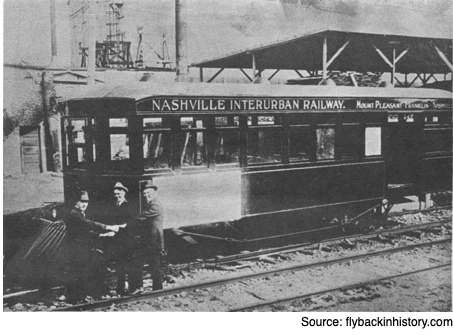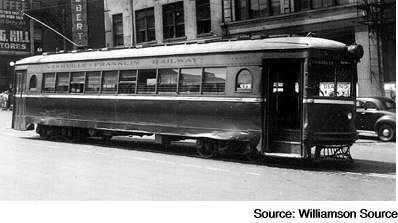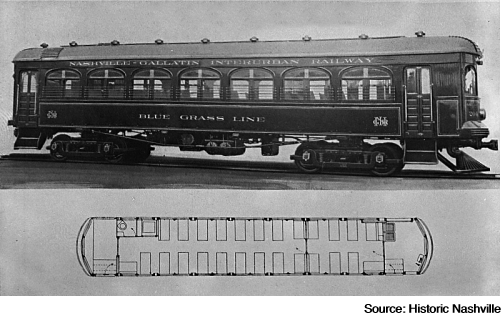 |
 |
|||

The Music City Star began weekday commuter service between Nashville and Lebanon on September 18, 2006, but it was 100 years too late to be Nashville’s first commuter rail.
 Exactly 100 years earlier, construction was under way on the first commuter rail — the Nashville and Franklin Railway, which began service in 1909 and lasted until the early 1940s. That service was joined in 1913 by a line to Gallatin.
Exactly 100 years earlier, construction was under way on the first commuter rail — the Nashville and Franklin Railway, which began service in 1909 and lasted until the early 1940s. That service was joined in 1913 by a line to Gallatin.
Both railways connected with the Nashville Railway & Light Co. – the in-town trolley service – at the old downtown transfer station, which was at Third and Deaderick.
These two railways were part of a huge technological fad that swept the nation in the first quarter of the 20th Century — the interurban railway. Interurban railways peaked in about 1916 during World War I and were eventually victims of cars, of paved highways and often of their own shoddy capitalization and operation.
Tonight I’m going to discuss the two interurban railways that originated in Nashville, but first let’s define an interurban railway and distinguish it from trolleys. The definition depends on circumstances and on technology.
The first American efforts with steel rails involved horse or gravity power and were primarily for industrial use such as mining or excavation in the early 19th Century.
The first locomotive-powered railroad was the Mohawk and Hudson in 1836 between Schenectady and Albany, N.Y. The locomotives were steam, of course, and that would be true for the next century as the railroad industry boomed and knit the nation together with rails.
But locomotives belching smoke, steam and cinders weren’t feasible for moving people within cities. Steam locomotives were also slow and inefficient for traveling short distances such as a few blocks between stops. And a steam train had to be turned at each end of the line, which wasn’t conducive to high-frequency urban service.
The first effort at what we’d come to know as trolleys was a horse-powered omnibus in New York City in the first part of the 19th Century. After beginning as conventional wagons, the omnibuses were converted to steel wheels on steel rails and became known as streetcars. The rails offered a better experience for the rider, and the reduced friction of steel on steel meant a horse could pull a bigger vehicle.
Horses have their limits, though, and those limits were tested in San Francisco. Andrew Smith Hallidie of that city filed a patent in 1871 for a cable car, and the first cable car trolley opened in 1873 in San Francisco.
For a while, cable cars boomed across the nation because they were superior to horse-drawn streetcars for a variety of reasons. By the end of the 19th Century, most large American cities had at least one cable car line, and Chicago had the largest network of cable cars.
Separately, inventors were experimenting with electricity. A series of discoveries in the 1830s led to functional electric motors, but they were small-scale and inefficient.
Nikola Tesla, among others, spent time experimenting with motors but moved on to other projects before producing any breakthroughs other than some unproven theories. Tesla’s theories, however, were tested by other scientists and proved to be keys to developing successful, large-scale electric motors in the last quarter of the 19th Century. Major discoveries in Europe and in the United States collided to create practical designs for more powerful motors.
And no place was more ripe for the application of electric motors than urban transportation — intracity trolley lines. Electric propulsion didn’t pollute as much, and the wires were easy to install in a city. Combined with the efficiency of steel wheels on steel rails, it was cost-effective. Add the ability to accelerate rapidly between frequent stops and reverse without turning the trolley car, and it was practical.
This was a winner. The first electric streetcar opened in 1887 in Richmond, Va., and this was the beginning of a nationwide boom. Nashville was beginning to electrify its city streetcars within one year. Within five years, electric streetcars were under construction in most major cities.
But these were intracity trolleys that went no farther than what were then regarded as suburbs. In Nashville, this meant Glendale Park south of Lipscomb University or Sylvan Park.
It wasn’t long, however, until America’s developers, promoters and civic leaders were contemplating the next logical step —·using electric streetcar technology to connect cities dozens or hundreds of miles apart with frequent, inexpensive and environmentally cleaner transportation.
 The competition was steam-powered railroads and unpaved toll roads. The railroads couldn’t compete on cost and frequency, and the issues with unpaved toll roads were dirt and mud besides the tolls.
The competition was steam-powered railroads and unpaved toll roads. The railroads couldn’t compete on cost and frequency, and the issues with unpaved toll roads were dirt and mud besides the tolls.
Thus was born the category of railroad called an interurban — a train using electric streetcar technology to connect non-contiguous cities, such as Franklin with Nashville or Gallatin with Nashville.
Interurbans were so popular that in one 1905 trade journal, I found a list of 23 announced contracts in cities you might never have heard of such as
- Cheshire, Conn.
- Bloomsburg, Pa.
- Henderson, Ky.
- Van Buren, Ark.
- Mineral Wells, Texas
The largest interurban system was Pacific Electric in southern California with a network of more than 1,000 miles.
Most citizens patronized the interurbans as passengers, but many interurbans also hauled freight. Tracks were usually built to American standard gauge, which permitted the interchange of freight cars. Often the freight service was provided overnight when the passenger service wasn’t operating.
Smack dab on the leading edge of this boom, Nashville got on the train, so to speak.
A steel magnate from Birmingham named Henry Hunter Mayberry moved to Nashville and began advocating an interurban railway. At a meeting in 1902, it was decided to organize two railways —·Nashville & Columbia and Nashville & Gallatin.
The project was opposed by the L&N Railroad, by the toll road operators and by Franklin merchants who thought they couldn’t compete with downtown Nashville.
The Franklin Appeal endorsed it, however. The newspaper correctly predicted an economic boom for Franklin because Nashville workers could buy homes in Williamson County and commute to work on the interurban. Arguably, that boom continues today.
From 1902 to 1905, $3 million of stock was sold for the Nashville-Franklin Railway, but construction hadn’t started. The board of directors hired Mayberry to take charge of the project.
He obtained additional financing. One source I read said the financing came from an institution affiliated with Andrew Carnegie, but I can’t make that fit Carnegie’s career timeline. Local businessmen J.H. Carpenter and J.W. Howard of the Tennessee Fertilizer Company also stepped in with more financing.
Mayberry chose a route along Franklin Pike. The interurban would come up from Franklin and connect with existing the Nashville trolley system at Glendale Park just south of present-day Lipscomb University.
Many property owners were so enthusiastic that they donated the 50-foot right of way along the highway for the interurban. Those donations weren’t always on the same side of the road, though. And the railroad also wanted to reduce grading expenses, so the interurban route zigged and zagged across Franklin Pike.
There might have been an initial test run on Christmas Eve 1908, but the 19-mile line to Franklin officially opened in April 1909. A band played Dixie as the first train arrived at the northeast corner of the square in Franklin. A big crowd was on site to celebrate, and the cars were overflowing.
The Franklin & Nashville Railway was immediately a success. Hourly service was provided from 6 a.m. until midnight. The fare was 10 cents. There were no official stops. Passengers just flagged down the train wherever they wanted to get on and rang the bell when they wanted to get off. The railroad carried about 30,000 passengers per month until Franklin Pike was paved in the 1920s. That cut ridership by about one-third, but the interurban continued to make a profit.
Breakdowns and delays were common. Sometimes the trolley pole came off the wire. Sometimes the power failed completely, stranding everyone until the power came back on. Livestock would block the train. But the line from Nashville to Franklin was popular and profitable.
It was so popular that visionaries were imagining extensions of the line as early as 1910, just one year after it opened. The records are slightly unclear, but apparently it would have been extended first to Eagleville in southern Rutherford County. Then separate routes would have gone to Shelbyville and to Lawrenceburg. Later, the ultimate destination was extended to Fayetteville. These people were dreaming big, but nothing happened.
By 1913, it was obvious that an extension of the electric interurban beyond Franklin wasn’t going to happen. In Eagleville, the civic disappointment was substantial. Someone named James Smith Ogilvie Jr. wrote the Eagleville Swan Song lamenting the demise of the railroad extension. It’s concluding words were
- Brother Sullivan he knelt down
- And all the others gathered round
- This is what they heard him say,
- “Now, Lord hear us pray.
- And send an interurban ‘round this way."
Meanwhile, the line to Gallatin had a slower start. A route was chosen in 1911 along Gallatin Pike. A competing route via Long Hollow Pike was considered but rejected because it was two miles longer and would have required more grading.
 The Gallatin line opened in 1913, about four years after the Franklin line. Nonetheless, it also was a success initially and was known as “The Blue Grass Line.” It connected with the city trolley system at Inglewood and wasn’t allowed to pick up passengers south of there so that it didn’t compete with the city trolley system.
The Gallatin line opened in 1913, about four years after the Franklin line. Nonetheless, it also was a success initially and was known as “The Blue Grass Line.” It connected with the city trolley system at Inglewood and wasn’t allowed to pick up passengers south of there so that it didn’t compete with the city trolley system.
Each route also had a milk train that would come downtown in the morning, stopping to pick up milk cans from farmers along the way. The train would operate in reverse in the afternoon, returning empty cans from dairies to farmers.
The milk trains also handled some other local freight business, but I don’t think it was substantial. After all, the L&N railroad served all of the cities concerned and pretty much had a lock on the business.
The Nashville-Gallatin Interurban Railway wasn’t as successful as the Franklin line. It went through receivership four years after it opened and emerged as the Union Traction Company of Tennessee. The popularity of the automobile and the increasing number of paved roads put economic pressure on interurban lines across the country. For many, the Great Depression was the end. The Gallatin line closed in 1932.
The Franklin to Nashville line continued to soldier on, however. It made a profit every year it existed.
Its death sentence came in the form of the decision in 1940 to close the Nashville Railway & Light Co. trolley system, effective in 1941. This deprived the interurban of its route to downtown. Shuttle buses were attempted from the terminus at Glendale Park to downtown, but even the transportation boom of World War II wasn’t enough. The Interstate Commerce Commission authorized abandonment in 1943.
Finally, I was prompted to choose this topic because of a videotape I bought many years ago with footage of the Nashville & Franklin Railroad. The movie (2:38) credits Dick George and dates it to 1940.